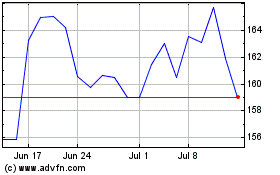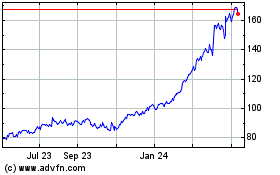By Ted Mann and Joshua Jamerson
General Electric Co.'s revenue declined 2% in the fourth
quarter, as the company dealt with a depressed oil industry and
shipped fewer jet engines and power turbines than it had
planned.
Although revenue was below investors' expectations, Chief
Executive Jeff Immelt said Friday that GE performed well, given its
exposure to a world economy that is growing slowly, and volatility
in the markets in which it operates. GE shares were off nearly 2%
in afternoon trading.
Once again, GE's biggest problem is oil. The company's
oil-and-gas unit, which makes equipment for petroleum exploration
and production, has been hammered by the more-than-two-year slump
in the price of crude, which prompted customers to rein in their
spending.
Oil-and-gas revenue in the fourth quarter fell 22% from a year
earlier, and segment profit fell 43%. GE recorded $12.9 billion in
sales in the oil-and-gas business last year, down from $16.5
billion in 2015 and $19.1 billion a year earlier.
GE remains committed to the oil business, and says it will be
poised to profit from an eventual rebound; but, meanwhile, the
company is restructuring and trying to limit the pain. In late
October, GE announced a deal to combine its oil-and-gas business
with Baker Hughes Inc., a move seen as a cost-effective way for GE
to reap the benefits of any recovery in the sector. Executives said
on Friday's earnings call that they expect that deal to close
midyear.
There were bright spots elsewhere, such as a 29% increase in
sales in the company's renewable-energy business, driven by a surge
of investment in onshore wind turbines. Revenue from GE's power
business, which makes gas turbines for power plants, rose 20%,
helped by the acquisition of Alstom's power business.
GE's industrial operating cash flow of $8.2 billion in the
fourth quarter made it "the biggest cash quarter in our history,"
Mr. Immelt said. Orders for GE equipment fell, for the quarter and
for the year, but orders for services rose by 20% in the fourth
quarter and 13% for the year.
Strong service orders bode well for the predictable industrial
earnings of the sort Mr. Immelt has been seeking in his
transformation of GE back into a more traditional industrial
company, after years of being powered by its lending arm, GE
Capital.
Mr. Immelt shrugged off a question about whether the incoming
Trump administration could play havoc with some of those business
lines.
A campaign adviser to Mr. Trump, Continental Resources Inc. CEO
Harold Hamm, has called for the elimination of renewable energy
subsidies -- a critical factor not just in sales of GE's wind
turbines, but also in some of its own energy-finance investments.
Also, Mr. Trump and the Republican Congress have pledged to undo
the Affordable Care Act, generating uncertainty in the health-care
industry that could slow sales of GE's medical equipment, like MRI
and X-ray machines. And Mr. Trump has pledged a resurgence in the
coal industry, while GE has positioned itself to benefit as
American utilities switch from coal to natural gas to generate
electricity.
"You could see some caution around the Affordable Care Act as
you go forward," Mr. Immelt said, but the industry hasn't shown
much disruption yet. Tax benefits for renewable energy are "pretty
much locked in place, " he said. "I still think the basic thesis
around gas power in the U.S. remains intact as it pertains to being
a base load technology in the future."
The current challenge for GE, now that it has pivoted away from
finance to refocus on industrial businesses, is to meet the demand
for its high-tech products, like jet engines and power
turbines.
GE delivered only 77 of its new LEAP aircraft engines, made in
partnership with France's Safran SA, down from a goal of 100
deliveries in 2016. Chief Financial Officer Jeffrey Bornstein said
the company met "all our commercial commitments" after
consultations with customers, and will deliver about 500 of the
engines in 2017.
The company also didn't meet its goals for power-turbine
shipments, a shortfall Mr. Bornstein attributed to the complicated
markets where GE increasingly does business. Six turbines that
company executives were convinced would be shipped by the end of
the year weren't shipped, Mr. Bornstein said, including four bound
for the Middle East.
"They were going into Bahrain and Iraq, and these were just
enormously difficult geographies to get stuff done," Mr. Bornstein
said. "And right up to the end of the year, we thought those
transactions were going to go. They didn't end up going. I think
we're confident they will go in the first half of 2017."
Overall for the latest quarter, GE's profit fell to $3.67
billion, or 39 cents a share, from a year-earlier $6.28 billion, or
64 cents a share, reflecting in part the paring back of GE Capital.
On an adjusted basis, earnings were 46 cents a share, in-line with
the consensus estimate from analysts polled by Thomson Reuters.
Revenue slipped to $33.1 billion from $33.89 billion in the
year-earlier fourth quarter, missing analysts' projections for
$33.63 billion.
Write to Ted Mann at ted.mann@wsj.com and Joshua Jamerson at
joshua.jamerson@wsj.com
(END) Dow Jones Newswires
January 21, 2017 02:47 ET (07:47 GMT)
Copyright (c) 2017 Dow Jones & Company, Inc.
GE Aerospace (NYSE:GE)
Historical Stock Chart
From Mar 2024 to Apr 2024

GE Aerospace (NYSE:GE)
Historical Stock Chart
From Apr 2023 to Apr 2024
